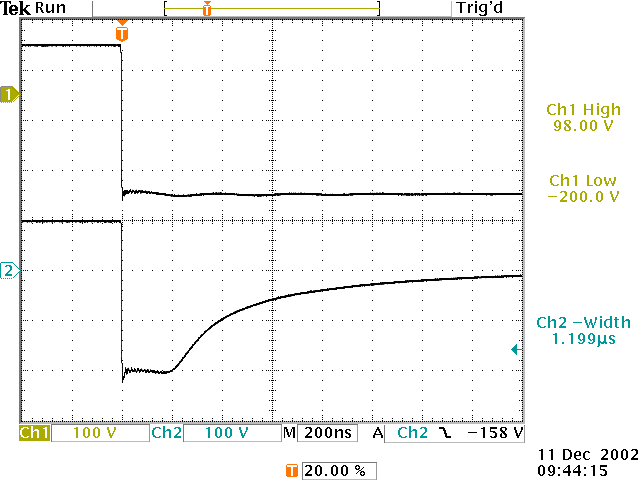Avtech model AVR-EB4-B is ideal for performing tRR
measurements on fast power diodes. The AVR-EB4-B is capable of
generating pulsed forward bias currents of up to +2A (for up to 10 us), followed by a reverse bias pulse of up to
-4A (again, for up to 10 us). The transition time from forward bias to reverse bias is less than 3 ns, allowing
ultra-fast rectifiers to be tested. The device under test (DUT) is connected in series with a 50 Ohm resistor. The
voltage across the resistor may be monitored to observe the diode current waveform. The general connection scheme
is illustrated below:

The 50 Ohm resistor provides a partial termination for the coaxial line connecting the AVR-EB4-B to the test jig. That is, it is a proper termination when the diode
is forward biased, but it is not a proper termination when the diode stops conducting in the reverse direction.
However, by keeping the coaxial cable length less than 8 inches (20 cm), the impedance-mismatch reflections are
minimal.
Some results for different diodes are shown below. In all cases, the forward bias is +100V (+2A), and the reverse bias is -200V (-4A), approximately. The top waveform is the input to the test jig, and the bottom waveform is the output. The "CH2 -Width" measurement at the right is a measure of the width of the waveform at the 10% reverse voltage point (-20V), which can be interpreted as tRR.
The first waveform shows the results obtained with an On Semiconductor 1N4937 diode. It displays the classis reverse recovery waveform, with a reasonably fast tRR of 154 ns:

The next waveform shows the results obtained with a Motorola 1N4004 diode. This is a dramatically slower diode, with a tRR of 1.2 us:

The third waveform shows the results obtained with a Diodes Incorporated UF1007 diode. This is a faster diode diode, but with a relatively sharp turn-off transient:

The last waveform shows the results obtained with an International Rectifier HFA08TB120S diode. This diode is noteworthy for it fast, but very "soft" (i.e., gradual) turn-off transient:

These waveforms demonstrate the versatility of the AVR-EB4-B. However, if the AVR-EB4-B doesn't meet your needs, send us your special testing requirement!
Some results for different diodes are shown below. In all cases, the forward bias is +100V (+2A), and the reverse bias is -200V (-4A), approximately. The top waveform is the input to the test jig, and the bottom waveform is the output. The "CH2 -Width" measurement at the right is a measure of the width of the waveform at the 10% reverse voltage point (-20V), which can be interpreted as tRR.
The first waveform shows the results obtained with an On Semiconductor 1N4937 diode. It displays the classis reverse recovery waveform, with a reasonably fast tRR of 154 ns:
1N4937 (40 ns/div)

The next waveform shows the results obtained with a Motorola 1N4004 diode. This is a dramatically slower diode, with a tRR of 1.2 us:
1N4004 (200 ns/div)

The third waveform shows the results obtained with a Diodes Incorporated UF1007 diode. This is a faster diode diode, but with a relatively sharp turn-off transient:
UF1007 (20 ns/div)

The last waveform shows the results obtained with an International Rectifier HFA08TB120S diode. This diode is noteworthy for it fast, but very "soft" (i.e., gradual) turn-off transient:
HFA08TB120S (40 ns/div)

These waveforms demonstrate the versatility of the AVR-EB4-B. However, if the AVR-EB4-B doesn't meet your needs, send us your special testing requirement!

